(Written by William)
In this Brick Breakdown series I review official LEGO sets, from the perspective of looking at interesting building techniques we can all learn from. Today we will be looking at the #76023 LEGO Batman Ultimate Collector Series Tumbler. You can also check out the previously discussed LEGO techniques found in official LEGO sets at the end of this article.
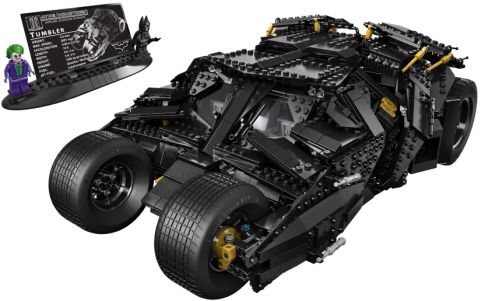
When it comes to LEGO, anything labeled Ultimate Collector Series (UCS), you know is bound to be something special. Problem is they are on the pricey side and can take up a monstrous amount of room. Fortunately, the LEGO Batman UCS Tumbler is a rather compact model so you won’t struggle finding a place to put it. With that said, it’s important to mention that this is more of a sculpted model and not at all meant for play. This means it is not the most durable due to a number of connection choices made in achieving all the very precise angles. So expect quite a few wedges in this set. Now let’s dive into the techniques used in this super special set!
SCULPTING WITH LEGO
As mentioned before, the LEGO Batman UCS Tumbler model is a bit on the fragile side. This is primarily due to the fact that it has a sculpted design. This is where you have a base frame which you then use to layer large detailed sections on. This approach is very different than the typical LEGO set in that stability is only a consideration for the frame you build off of. Take for example a clay sculpture; normally when you are making something out of clay, you’ll build up the general shape first. Once this is done, you then proceed to sculpt details out of or onto the base. Since LEGO can only be built up if you are not modifying elements, you will only be building onto a frame. While sculpting out of LEGO you can layer elements through hinge work, angle sections via clips and bars, and mislead the eye with slopes. The end result is a lot of nontraditional lines that although can produce some impressive models, also loose stability.
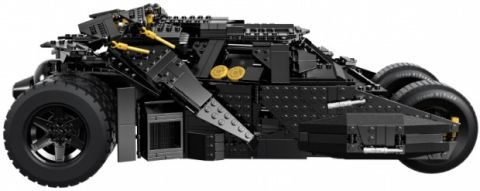
In order to practice this technique you will really need to work on building a strong foundation. This not only means connecting solidly with overlapping stud connections, but also horizontally with LEGO’s pin elements. Next, you will need to work into the foundation enough connection points for later decorative elements. This often entails strong understanding of brackets, pin connections, and the occasional clip and bar placement. Finally, you will need to think in terms of layers. Each layer going outward should further define the shape you want. So, as an example, a human head starts with a head shape. Then the next layer may define the chin, eye-sockets, brow-ridge, and cheek-bones. The next layer handles facial-hair like eyebrows and intricate shapes like the nose. Essentially, you are rendering a complex shape with every pass bringing you closer to the final product.
STRUCTURAL FRAMING WITH LEGO
In large designs like the LEGO Batman UCS Tumbler, it is absolutely essential to know when and where to make your structural frame. This will be the general shape that maps out the full size of the model. For many large vehicles, the rectangular LEGO Technic bricks make an excellent quick frame without sacrificing stability. Once the shape is defined, you can then create the canvas. This is often a very flat studded surface like a standard plate.

Once you get to this stage it means you probably won’t be building anything too significant away from the frame. The exception to this is if you are building to another structural frame. If you need any other reason why a structural frame is so necessary, it is the way you will be able to move a model. As strong as LEGO elements are, they can only hold so much weight unless you plan for it. This is why it’s sometimes impossible to move LEGO castles from one point to another; they are usually pretty big, and they have little to no structural frame in place to act as a single movable model.
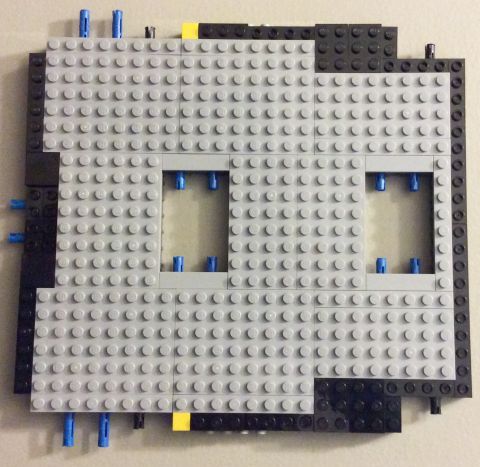
CURVING WITH TECHNIC ANGLES
Most people start with basic LEGO System style elements – it’s just simpler to understand that studs connect with tubes. It’s practically a new system when people first experience LEGO Technic elements like axle-rods or snap-pegs (also referred to as pins by some LEGO fans). Nevertheless, LEGO continues using both systems together and you’ll develop a small collection of parts you’ll rarely use. So it is with this in mind that we look at a very basic technique that may help you ease into the idea that these two systems work well together.
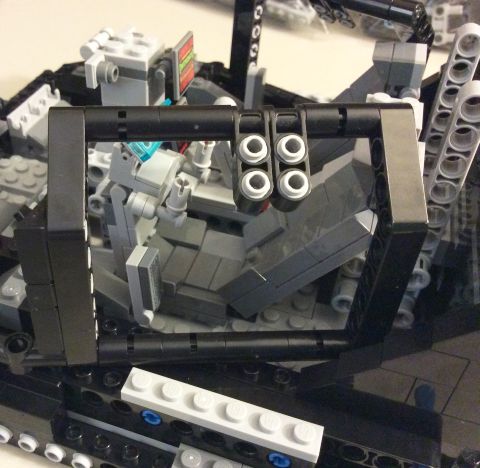
Take for instance, your basic angled connector; it holds two axles together and has a pinhole in the middle. From the outset it doesn’t seem very important to stud use. In this set they use a few Technic bricks with axle holes to make things a bit more compatible. Then they do something really simple; they angle one connector one way and a second in the opposite direction. These are, of course, connected with axles. Then they connect some of those Technic bricks with axle holes to the end. Then this is placed straight onto studs. Essentially what happens is that the two curves cancel each other out making them align with the straight rows of studs. However, now there is an interesting angled rod between the two connectors. In the LEGO Batman UCS Tumbler, curved lift-arms are used to build off of the axle, but you can use a much wider variety of elements, like more axle bricks. The nice thing with using axles is that you don’t have to be exact. They have a bit of wiggle room to let you experiment with. And once you’re ready for it to take up a very specific amount of shape, chances are there is an axle at that length.
BUILDING SUSPENSIONS WITH LEGO
Normally you probably don’t have to worry about adding a suspension to your LEGO vehicle. In this model, with the gigantic wheels needed to keep the vehicle in scale, LEGO designers work around the issue by having specialized connection-points for the monster doughnut wheels. Unfortunately you may not have this luxury. So here are a couple of tips to keep your vehicle from tipping.
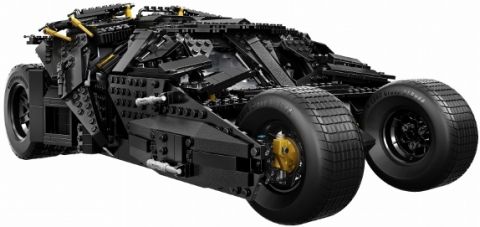
First, make sure the wheels are connected into the structural frame. If they are not, have reinforced sections that they connect into. Next, assure that the weight is evenly distributed. This is typically done by putting the wheels as far out as possible at the corners of the vehicle. Finally, you will need to take into consideration that the element used for allow turning movement can handle the weight of what is turning.
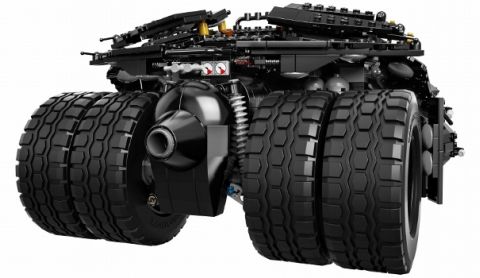
This may mean you want to rig up something that utilizes multiple axles. In general, the smaller the piece the more sturdy it will be, but it gives up surface area to hold onto other things. For example a single pin is sturdy but it doesn’t have the reach of an axle. However, if the axle is too long, it leaves itself vulnerable to bending. Often the key is redundant parts use. So a series of pins in a gear are stronger than one. Just like a series of axles working together can handle more weight.
APPLYING WHAT YOU LEARN
Sculpting with LEGO is not necessarily a skill you need to master to be a great builder. It is rather another option of design you can pursue. There are many principles in design that good sculpting ignores, but you can keep it in mind as an optional tool when looks are the major priority. Structural framing and suspension are two similar techniques as they both deal with the overall stability of a LEGO model. One is simply a foundational base while the other figures out how to span distances when you don’t have anything between two points. In the end, suspension props up structural frames. That’s ultimately how they complete one another. Finally, there is experimenting with multiple systems. This is often what leads to novel designs since what one system lacks, the other might excel in.
So what do you think? How do you like the new LEGO Batman UCS Tumbler sets? Have you had a chance to build it? Did you learn from the interesting building techniques used in the sets? Feel free to share your own experiences and tips, or ask questions in the comment section below!

And you might also like to check out the other reviews in this series:
- Brick Breakdown: LEGO Minecraft The Cave
- Brick Breakdown: LEGO Minecraft Ender Dragon
- Brick Breakdown: LEGO Santa’s Workshop
- Brick Breakdown: LEGO Ideas Exo Suit
- Brick Breakdown: LEGO Ideas Research Institute
- Brick Breakdown: Emmet’s Contruct-O-Mech
- Brick Breakdown: LEGO Forest Animals
- Brick Breakdown: LEGO King’s Castle
- Brick Breakdown: LEGO Cinderella’s Castle
- Brick Breakdown: LEGO MetalBeard’s Sea Cow
- Brick Breakdown: LEGO MetalBeard’s Duel
- Brick Breakdown: LEGO Minecraft Sets
- Brick Breakdown: LEGO Disney Princess Sets
- Brick Breakdown: LEGO Back to the Future DeLorean
- Brick Breakdown: The LEGO Movie Ice Cream Truck
- Brick Breakdown: LEGO Parisian Restaurant
- Brick Breakdown: The LEGO Movie Flying Flusher
- Brick Breakdown: LEGO The Hobbit Dol Guldur Battle
- Brick Breakdown: LEGO Winter Village Cottage
- Brick Breakdown: LEGO Winter Village Market
- Brick Breakdown: LEGO Lord of the Rings Council of Elrond
- Brick Breakdown: LEGO Castle Dragon Mountain
- Brick Breakdown: LEGO Lord of the Rings Pirate Ship Ambush
- Brick Breakdown: LEGO Ninjago Golden Dragon
- Brick Breakdown: LEGO Superman Black Zero Escape
- Brick Breakdown: LEGO Tower of Orthanc
- Brick Breakdown: LEGO City Dump Truck
- Brick Breakdown: LEGO Monster Fighters Ghost Train
- Brick Breakdown: LEGO Lone Ranger Silver Mine Shootout
- Brick Breakdown: LEGO Lone Ranger Constitution Train Chase
- Brick Breakdown: Ninjago Temple of Light
- Brick Breakdown: LEGO Lone Ranger Colby City Showdown
- Brick Breakdown: LEGO Lone Ranger Comanche Camp
- Brick Breakdown: LEGO Lone Ranger Stagecoach
- Brick Breakdown: LEGO Star Wars AT-RT
- Brick Breakdown: LEGO Arkham Asylum Part 1
- Brick Breakdown: LEGO Arkham Asylum Part 2
- Brick Breakdown: Legends of Chima Polybags












This set is such a beast. In a good way. I find the sculpting techniques you mentioned above particularly interesting. It makes the set more fragile, but allows some very interesting angles.
Wow, complicated stuff! I tried building this set on LDD using only pictures and parts pages, but didn’t get very far. It was too difficult to see how everything went. But I love all that Technic stuff; when I see it on a system set, I get super excited. 🙂 Great Breakdown, though, even though you forgot to mention the fake suspension on the rear wheels. 😉
Also, off-topic, @admin, did you find someone to go to the NY Toy Fair for TBB? I was wondering because my mom said she could get me to new york city on the 14th, if I had all the necessary info and requirements to get in. So I could go if you still need a representative.
Thanks for the offer, I think we are covered though. I have a friend in NY who is planning to go with his brother. They covered the event for us previously as well. I can keep you in mind for the future though. It is very interesting to go and you get a feeling of what it’s like to be a real reporter. 😉
Okay, that’s great. My dad was on the site for the fair, and he found that one has to be 18 or older to go… I don’t know if that includes the “press” but I’m not 18 – yet. 😐 But good to know that we’re getting coverage. 🙂
This is only $200.00? It’s cheaper than I thought it would be. What are the exact measurements for the tumbler anyway?
From the press-release we shared some time back: Tumbler measures over 5” (15cm) high, 15” (40cm) long and 9” (24cm) wide. 🙂
Whoa awesome! I guess I can understand the price for it then. And like you said, it’s more compact and easier to display. Well, as much compact as you can get for a massive set like this. 🙄
Wasn’t this set fan made, or am I confusing it with something else?
This is not a LEGO Ideas set, all fan-made submissions (if approved by LEGO) get released under the LEGO Ideas theme. 🙂
Very interesting, cool figures. I was happy to see that it will be only 199.99, which is cheap for this big of a set, especially since it is a UCS. Definitely going on my Christmas List this year, or maybe for my birthday! :3